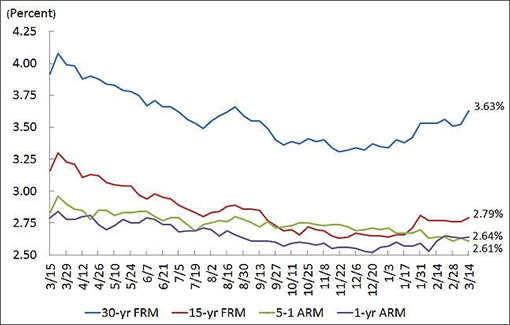
According to Freddie Mac’s latest Primary Mortgage Market Survey, 30-year fixed-rate mortgage rates averaged 3.63 percent (with 0.8 points) for the week ending today, up from 3.52 percent the week before and an all-time low of 3.31 percent in November, but versus 3.92 percent a year ago.
The average 15-year fixed mortgage rate was 2.79 percent, up from 2.76 percent the week before but versus 3.16 percent a year ago.
As rates ticked up, mortgage applications to purchase homes in the U.S. fell 1 percent but remain 9 percent higher on an unadjusted year-over-year basis. Refinancing activity fell 5 percent last week according to the Mortgage Bankers Association.
∙ Mortgage Rates up on Signs of Improving Economy [Freddie Mac]
∙ Mortgage Applications Decrease in Latest MBA Weekly Survey [mbaa.org]

When is the ARM/Alt-A interest rate reset tsunami hitting again?
… And why was it that every single thing that Tipster and LRIM say about SFRE prove false? Population declining, Noe tanking, social media is nothing, job market goin to be lousy, all advertised rents “wishing,” and on and on and on.
Because they have a fundamentally flawed view of observing the world. One did not believe in modern economics and imagined everything through the lens of a cranky fringe theory and the other was just cranky. Negativism rarely rules the day.
“When is the ARM/Alt-A interest rate reset tsunami hitting again?”
When Ben’s printing press runs out of ink.
Very interesting numbers. Historical mortgage rates, if there is such a thing, are supposed to be in the 6%-8% range. As the market keeps recovering rates might creep higher past 4% without too much damage. After that (>5%) this could cause some sizable troubles to the market. Big parts of the SF market still rely on mortgages. It is not neutral and this would cool off the little hysteria we’re having today, which is not really a bad thing.
[Editor’s Note: The long-term average since 1971 is 8.7% (see Mortgage Rates Drop, But Set To Start Ticking Up This Year?).]
^ True, and thanks for the chart.
I couldn’t find reliable sources of mortgage rates prior to 1971, except a few ones saying is was in the 5% (50s, 60s) to 7% (30s). The 70s-80s were everything but typical due to double-digits inflation and high economic instability.
http://www.ehow.com/about_5576484_history-mortgage-interest-rates.html
I can’t imagine what this market would look like with a 8.7% fixed rate. Then again, this would mean high inflation…
Scare tactics are dead. San Francisco never really took a Alt-A hit and it won’t, either.
I don’t think Alt-A is being debated here
Really?…because Repornaddict asked about it and deimos answered that it is coming when the ink runs out.
Strike that. There are 2 discussions there.
Alt-As are not an issue in SF though I think. The revival of this discussion would be from the crowd who’d wants to go back to 2009.
People with bad finances already failed. The ones who could wait out the crash are rescued by the market.
diemos wrote:
You’re going to be waiting for a long time.
I don’t believe The Fed can’t run out of “ink” as long as the U.S. has it’s own fiat currency. But let’s suppose diemos is instead referring to The Fed’s unusually accommodative monetary policy. From yesterday’s WSJ, Easy-Money Era a Long Game for Fed:
Emphasis mine.
Just throwing down a marker here. If we are all still reading ss in 2020, I’ll be able to reference this comment and compare what actually happened to the expert predictions.
People with bad finances already failed.
I’m looking at a really old printout of the Credit Suisse reset chart and resets really tail off from summer 2012 to winter 2012. I imagine some NOD’s were issued and we will be seeing some foreclosures from this final wave. Otherwise, as we all know, many experienced the trauma of ‘full amortization’ as “look what happened, my payment went down”. ARMaggedon has been postponed until further notice.
Brahma,
From what I understand, the Fed has purchased so much mortgage debt that it cannot get out that easily.
Higher interest rates would make the bonds currently on their balance sheet less valuable and the Fed would incur very politically damaging losses.
The Fed doesn’t care if it takes losses! They are deliberately shifting the loss of the phoney money that the shadow banking system pushed into circulation onto themselves so that the banks don’t all collapse.
Losses would make their life easier when the economy picks up, they won’t have to sterilize so much of the money they injected into the economy in the 2009-2011 era.
One other thing, in addition to what NoeValleyJim wrote: as I understand it, The Fed was and is buying the actual bonds, not some kind of fund or derivitive, and they have a large degree of independence; that means they can play the role of the patient investor that Walter Bagehot’s famous rules call for, and simply let the bonds on their balance sheet mature instead of selling them on the open market.
This patient investor has more than 3T and is still “investing” at the clip of 80+B/month.
It is true that they can take their time but one day they’ll have to divest and realize losses. Hopefully the US economy will have grown fast enough for these Trillions to be esily absorbed. There are a few “ifs” in this logic.
But I think that so far they’ve done a pretty good job. I hope this doesn’t come back to haunt us later.